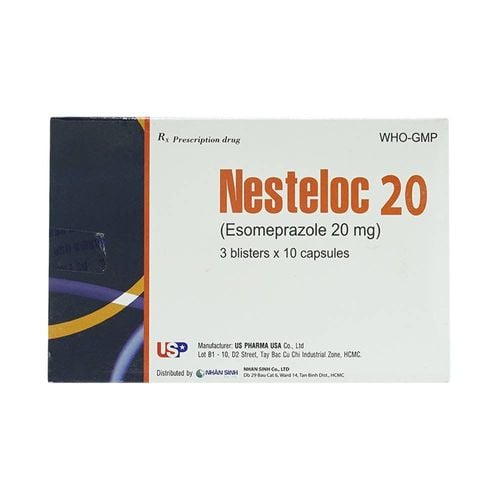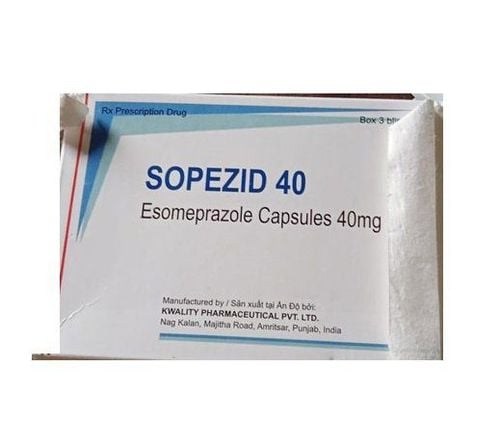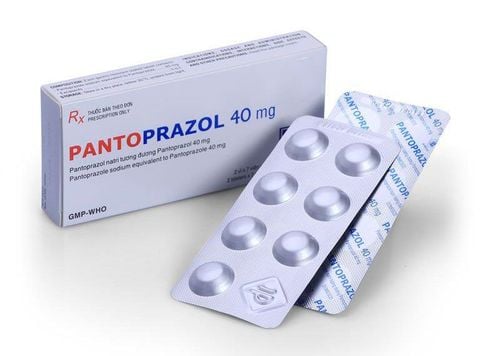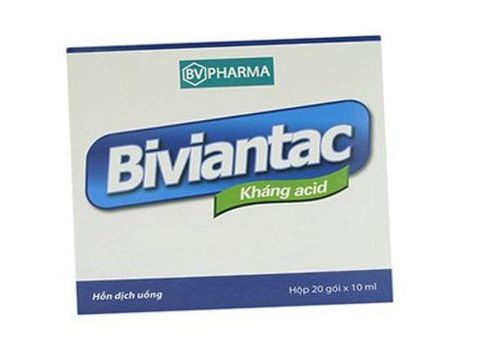This is an automatically translated article.
Esomeprazole 20mg drug contains the active ingredient Esomeprazole, indicated in the treatment of gastroesophageal reflux syndrome - oesophagitis, peptic ulcer disease, prevention and treatment of gastric enzyme - duodenal ulcers caused by anti-inflammatory drugs. .. Learn about the use and dosage of esomeprazole 20mg through the article below.1. Uses of Esomeprazole 20mg
1.1. Indications "What are the effects of esomeprazole 20mg?" . Esomeprazole 20mg drug contains the active ingredient esomeprazole, made in the form of hard capsules, indicated in the treatment of the following conditions:
Treatment of gastroesophageal reflux disease syndrome - oesophagitis; Treatment of peptic ulcer disease - oesophagitis; Treatment of stomach ulcers caused by Helicobacter pylori infection, preventing the risk of recurrence in patients with peptic ulcers infected with Helicobacter pylori; Prevention and treatment of gastric and duodenal ulcers caused by non-steroidal anti-inflammatory drugs. 1.2. Pharmacodynamics Esomeprazole belongs to a class of proton pump inhibitors that reduce gastric acid secretion by specifically inhibiting the enzyme H+/K+ - ATPase in the parietal cells of the stomach. Esomeprazole is the S-isomer of Omeprazole, which is converted and protonated in the acidic compartment of the cell to form the active inhibitor sulphenamide. The specific action on the proton pump enables esomeprazole to block the final step in acid production, thereby helping to reduce gastric acidity. The effect of esomeprazole is independent of dose (dose ranges from 20 to 40 mg/day).
1.3. Pharmacokinetics Absorption: Esomeprazole is rapidly and completely absorbed after oral administration. Peak drug concentrations are reached after 1-2 hours. Esomeprazole has an increased bioavailability with dose and with repeated administration (approximately 68% for the 20 mg dose and 89% for the 40 mg dose). The process of drug absorption is reduced under the effect of food, the area under the curve (AUC) when a single dose of 40 mg with meals is reduced by about 33 - 53% compared to fasting. Therefore, it is recommended that esomeprazole be taken approximately 1 hour before a meal.
Distribution: 97% of an administered dose of esomeprazole is bound to plasma proteins.
Metabolism: The drug is metabolised in the liver via the cytochrome P450 isoenzyme CYP2C19 system to inactive demethyl and hydroxyl derivatives, a small part is metabolised via the CYP3A4 isoenzyme to esomeprazole sulfone derivatives. Esomeprazole is used in repeated doses, the metabolism through the liver, the clearance of the drug is reduced because the isoenzyme CYP2C19 is inhibited. However, there was no accumulation of the drug with once-daily dosing. Some patients with inherited deficiency of the CYP2C19 isoenzyme slow down the metabolism of esomeprazole, resulting in a 2-fold increase in AUC compared to those with sufficient enzyme.
Elimination: 80% of a dose of esomeprazole is eliminated as inactive metabolites in the urine, a small part is excreted in the faeces. The half-life of esomeprazole is 1 to 1.5 hours (less than 1% of the parent drug is excreted in the urine). For people with severe liver failure, the AUC value is 2-3 times higher than that in people with normal liver function, so it is necessary to reduce the dose in these subjects and note that the dose should not be higher than 20mg per day.
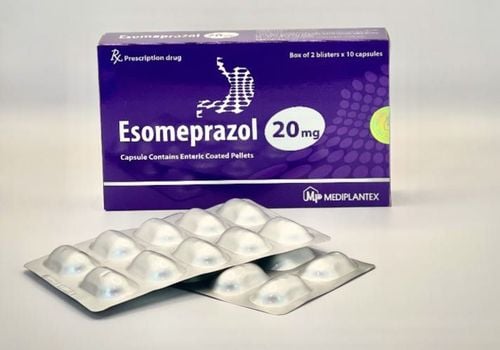
Thuốc Esomeprazol 20mg được chỉ định trong điều trị một số bệnh lý dạ dày
2. Dosage of esomeprazole 20mg
Esomeprazole 20mg drug is used to treat and prevent peptic ulcer disease, the dose depends on the specific condition of the patient. The drug is to be swallowed whole, without chewing, breaking, or crushing the tablet. It should be taken before breakfast for maximum effect. The specific dosage of esomeprazole 20mg is as follows:
Gastroesophageal reflux syndrome: The starting dose is 20-40mg/day, can last from 4 to 8 weeks in patients who do not heal after 4 days. - 8 weeks of treatment. In case of maintenance treatment or asymptomatic disease of esophageal erosion, the dose can be maintained at 20mg/day. Peptic ulcer disease caused by Helicobacter pylori: Use esomeprazole 20mg in combination with clarithromycin and amoxicillin. Dosage is usually 20mg/time x 2 times/day for 7 days or 40mg/time x 1 time/day for 10 days. Stomach and duodenal ulcers caused by nonsteroid anti-inflammatory drugs: The recommended dose of esomeprazole is 20mg or 40mg x 1 time / day, maintained for 6 months. Patients with hepatic impairment: For patients with mild and moderate hepatic impairment, no dose adjustment is required. For patients with severe liver failure, the dose should not exceed 20 mg/day.
3. Side effects when using esomeprazole 20mg
Some possible side effects when using esomeprazole 20mg are as follows:
Common side effects (ADR > 1/100): Neurological symptoms such as dizziness, headache. Gastrointestinal symptoms such as diarrhea, abdominal pain, constipation, flatulence. Uncommon side effects (1/1000 < ADR < 1/100): Skin itching, urticaria, dermatitis, dizziness, dry mouth. Rare side effects (ADR < 1/1000): Systemic side effects such as fever, sweating, peripheral edema, angioedema, urticaria, anaphylaxis, bronchospasm, agranulocytosis, decreased thrombocytopenia, leukopenia, photosensitivity, hepatitis, elevated liver enzymes, liver failure, musculoskeletal pain. If side effects appear when using esomeprazole 20mg, the patient should stop using the drug and notify the treating doctor.

Thuốc Esomeprazol 20mg có thể gây ra một số tác dụng phụ khi sử dụng
4. Notes when using esomeprazole 20mg
4.1. Contraindications Contraindicated to use esomeprazole 20mg in cases of hypersensitivity to proton pump inhibitors, hypersensitivity to any component of esomeprazole.
4.2. Precautions when using the drug Some notes when using esomeprazole 20mg are as follows:
In case of occurrence of warning symptoms when taking the drug such as recurrent vomiting, significant weight loss, vomiting blood, difficulty swallowing, Black blood in the stool... or when there is suspicion of gastric ulcer, the risk of stomach cancer must be excluded, because treatment with esomeprazole 20mg can reduce symptoms and delay the diagnosis of the disease. . Caution should be exercised in prolonged treatment with esomeprazole 20mg because of the risk of atrophic gastritis. Use caution when treating patients under 18 years of age. Use with caution in people with liver disease, pregnant or lactating women. No dose adjustment is required for patients with renal impairment, however caution should be exercised in patients with severe renal impairment. Driving and operating machinery: Some patients may experience headache, dizziness, and lightheadedness when taking the drug, so caution should be exercised when using esomeprazole in a driver or a machine operator. Pregnant women: Esomeprazole does not affect the development of the fetus, however, it should be used with caution and only used in pregnant women when absolutely necessary. Lactation: Do not use the drug in women who are breast-feeding.
5. Drug interactions
The drug esomeprazole inhibits gastric acid secretion, increases gastric pH, so it may affect the bioavailability of pH-dependent absorbed drugs such as digoxin, ketoconazole, iron salts... Clarithromycin, esomeprazole and Co-administration of amoxicillin increases blood levels of esomeprazole and 14-hydroxyclarithromycin. Concomitant administration of diazepam and 30 mg of esomeprazole resulted in a 45% decrease in clearance of diazepam. Esomeprazole increases blood levels of saquinavir and decreases levels of nelfinavir and atazanavir through an undefined mechanism. Therefore, consideration should be given to reducing the dose of saquinavir when co-administered with esomeprazole to avoid possible adverse effects of saquinavir. Esomeprazole reduces the activity of the enzyme that converts clopidogrel to the active form, thereby reducing clopidogrel's activity. Therefore, it is recommended to use two drugs only when absolutely necessary, the benefits outweigh the risks. Co-administration of esomeprazole with cilostazol increases the concentration of cilostazol and its metabolites. Therefore, the dose of cilostazol should be reduced from 100 mg/time x 2 times/day to 50 mg/time x 2 times/day when co-administered with esomeprazole. Esomeprazole 20mg medicine contains the active ingredient Esomeprazole, which is indicated in the treatment of gastroesophageal reflux syndrome - oesophagitis, peptic ulcer disease, prevention and treatment of gastric enzyme - duodenal ulcers caused by anti-inflammatory drugs. To ensure effective treatment, patients need to take medicine according to prescription or consult a doctor, pharmacist for advice.
Follow Vinmec International General Hospital website to get more health, nutrition and beauty information to protect the health of yourself and your loved ones in your family.
Please dial HOTLINE for more information or register for an appointment HERE. Download MyVinmec app to make appointments faster and to manage your bookings easily.




